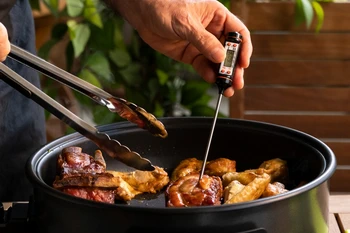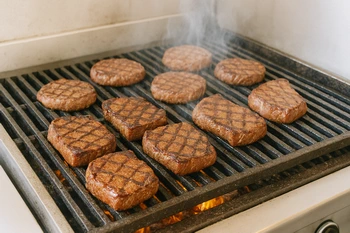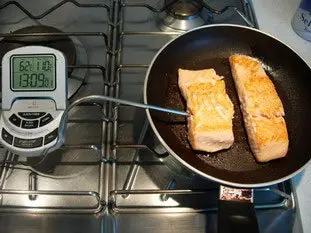The thermometer is your friend

There are many recipes or foods that require a (very) precise cooking temperature: foie gras, sugar for caramel, meats and fish, and not forgetting pastries. For these few examples, getting the cooking temperature wrong can spoil the whole recipe or dish: undercooked, it's no good or misses the mark; overcooked, it can become hard, dry or inedible.
It's not easy to judge cooking or temperature by eye, but fortunately you have an indispensable friend in the form of a thermometer.
It's not easy to judge cooking or temperature by eye, but fortunately you have an indispensable friend in the form of a thermometer.
2,681 5/5 (4 reviews)
Keywords for this post:CookingPastryBakeryTemperatureBakingThermometerElectronicLast modified on: April 10th 2025
The thermometer is your friend
A catering professional has a keen eye, he or she is able to see or sense if the cooking is finished, or if it needs to be continued, simply by virtue of his or her long experience. It's always amazing to see a rotisserie chef, or a rotisserie cooker, who can manage a 1-square-meter griddle, and who is able to start cooking 5 or 6 pieces of meat at the same time, or more, and to know when to stop the "blue", the "rare" and the "medium" at the right moment.
Obviously, this is something we amateurs are hardly capable of. It's not so easy to cook fish properly, and nothing is better than a perfectly cooked fish fillet: neither too much (it dries out and hardens), nor too little (it's not sushi, being "pearly" when cooked isn't always enough).
You might think that it's only a question of time: if you put your tournedos on the stove for x minutes, it will be cooked to perfection, or if you put your roast in the oven for y minutes, it will be too. But no, it doesn't work like that, because the heat source is highly variable: you put your frying pan on the fire, and it takes a certain amount of time to reach the right temperature, depending on your setting; your meat may have just come out of the fridge, so it's cold, which means it will take longer to cook, whereas meat at the right temperature will cook faster, in short... It's almost mission impossible.
So, should we give up? No, in fact, technology can come to our rescue in a very simple way: since cooking means reaching a certain temperature, and this temperature can be measured with a thermometer, we can rest easy enough on that.
Returning to the story of the undercooked fish, it's enough to know that fish is (generally) perfectly cooked if it reaches 60°C at the core. To cook your fish successfully, put it in the oven or on the stove, stick a thermometer probe in it and wait for it to reach the famous 60°C, then remove from the heat and serve within 3 to 5 minutes. You'll be amazed at the results.
It works for just about any type of cooking, and above all, it's completely environmentally friendly: is my oven/oven hot? Is my meat or fish at room temperature or not? Is the thickness of my foie gras even? Is my sugar "grand cassé" rather than blond caramel? None of this matters, only the core temperature of your dish.
If you're going down this road, you'll need a good thermometer: opt for an electronic one that goes up to 300°C, with an oven-safe stainless steel probe (some kitchen ovens now include a probe), and if possible a temperature alarm: it beeps loudly when the indicated temperature is reached, allowing you to do something else while cooking. It's not cheap, but it's a good investment, and once you've tried it, you'll see that it's a life-changing device.
To sum up: when cooking, only the core temperature counts, and the thermometer is ideal for that.

Obviously, this is something we amateurs are hardly capable of. It's not so easy to cook fish properly, and nothing is better than a perfectly cooked fish fillet: neither too much (it dries out and hardens), nor too little (it's not sushi, being "pearly" when cooked isn't always enough).
You might think that it's only a question of time: if you put your tournedos on the stove for x minutes, it will be cooked to perfection, or if you put your roast in the oven for y minutes, it will be too. But no, it doesn't work like that, because the heat source is highly variable: you put your frying pan on the fire, and it takes a certain amount of time to reach the right temperature, depending on your setting; your meat may have just come out of the fridge, so it's cold, which means it will take longer to cook, whereas meat at the right temperature will cook faster, in short... It's almost mission impossible.
So, should we give up? No, in fact, technology can come to our rescue in a very simple way: since cooking means reaching a certain temperature, and this temperature can be measured with a thermometer, we can rest easy enough on that.
Returning to the story of the undercooked fish, it's enough to know that fish is (generally) perfectly cooked if it reaches 60°C at the core. To cook your fish successfully, put it in the oven or on the stove, stick a thermometer probe in it and wait for it to reach the famous 60°C, then remove from the heat and serve within 3 to 5 minutes. You'll be amazed at the results.

It works for just about any type of cooking, and above all, it's completely environmentally friendly: is my oven/oven hot? Is my meat or fish at room temperature or not? Is the thickness of my foie gras even? Is my sugar "grand cassé" rather than blond caramel? None of this matters, only the core temperature of your dish.
If you're going down this road, you'll need a good thermometer: opt for an electronic one that goes up to 300°C, with an oven-safe stainless steel probe (some kitchen ovens now include a probe), and if possible a temperature alarm: it beeps loudly when the indicated temperature is reached, allowing you to do something else while cooking. It's not cheap, but it's a good investment, and once you've tried it, you'll see that it's a life-changing device.

To sum up: when cooking, only the core temperature counts, and the thermometer is ideal for that.
Lasts posts
Cake moulds
When we make a cake, or a cake of the same rectangular shape, we usually take out our usual mould and tell ourselves that the recipe is anyway "for a cake", but is it really that simple?August 25th 20257305
Thinning out herbs
If you need to add a long-stemmed herb (tarragon, mint, verbena, thyme, etc.) to a recipe, you'll probably only need the leaves and not the stem, so you'll need to remove the leaves. Leaf removal means keeping only the beautiful leaves, and eliminating the ugly stems and leaves, but how do you do...August 8th 20251,1845
Add a bay leaf
Bay leaf: small in size, but big in flavor. You'll find it in hundreds of recipes, and it's often added to cooking meat, in a sauce or broth, usually accompanied by other herbs or products. It's a staple of Provençal, Mediterranean and Oriental cuisine, but not the only one. Usually, in a...July 31th 20251,2775
Parsley stems
Parsley, whether curly or flat, is a delicious ingredient in many recipes, where it is used both raw and cooked. When used raw, in a salad for example, where it always provides, alone or with other herbs, a remarkable freshness, only the leaves are kept. And when used cooked?July 28th 20251,359 13
A drizzle of olive oil
Often in a recipe, you have to "baste" vegetables, for example, before sending them to the oven. What the author means by this is that you need to put oil on top of the vegetables to cook them in the oven. Typically, we just quickly drizzle oil over the vegetables, hoping not to miss any, but...July 13th 20251,5515
Other pages you may also like
Thinning out herbs
If you need to add a long-stemmed herb (tarragon, mint, verbena, thyme, etc.) to a recipe, you'll probably only need the leaves and not the stem, so you'll need to remove the leaves. Leaf removal means keeping only the beautiful leaves, and eliminating the ugly stems and leaves, but how do you do...August 8th 20251,1845
In praise of Mont d'Or cheese
Do you know the Mont d'Or, this extraordinary cheese from the Haut-Doubs in France, with a unique taste and appearance, which can be eaten both raw and cooked? I'll tell you a few words about it, and with some tips on how to choose it and cook it. .November 27th 202110 K5
The little trap of thick cream
When you need to add cream to a recipe, you might be wondering: thick (heavy) cream or liquid cream? In most cases, there's no big difference: you can use either. But there is one exception, and that's when the cream needs to be cooked, for a sauce for example, and here the difference between...December 13th 20244,6635
Fruits which can ruin your jelly
There are many ways of making a fruit mousse, but one of the simplest is to prepare a fruit jelly (basically a fresh fruit coulis with gelatine) and then mix this jelly before it sets completely with whipped cream. The result is perfect for filling a charlotte, for example. But do beware;...March 6th 201375 K4.0
The window-pane test in bread-making
The home bread-makers often ask themselves “Have I kneaded my dough long enough?” . A good question, as dough that is insufficiently kneaded will not rise properly or will fall flat when the top is slashed, which is very frustrating. To know when the dough is ready, one can rely on the length...June 16th 202192 K 23.9
Post a comment or question
Follow this page
If you are interested in this page, you can "follow" it, by entering your email address here. You will then receive a notification immediately each time the page is modified or a new comment is added. Please note that you will need to confirm this following.
Note: We'll never share your e-mail address with anyone else.
Alternatively: you can subscribe to the mailing list of cooling-ez.com , you will receive a e-mail for each new recipe published on the site.








